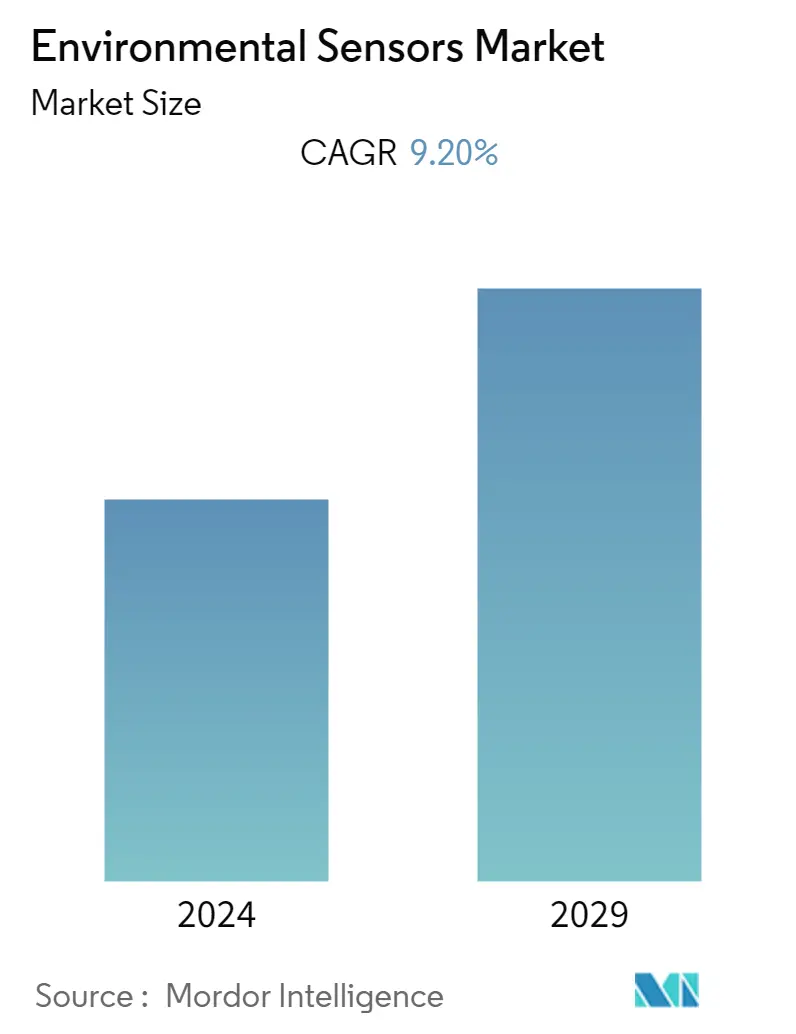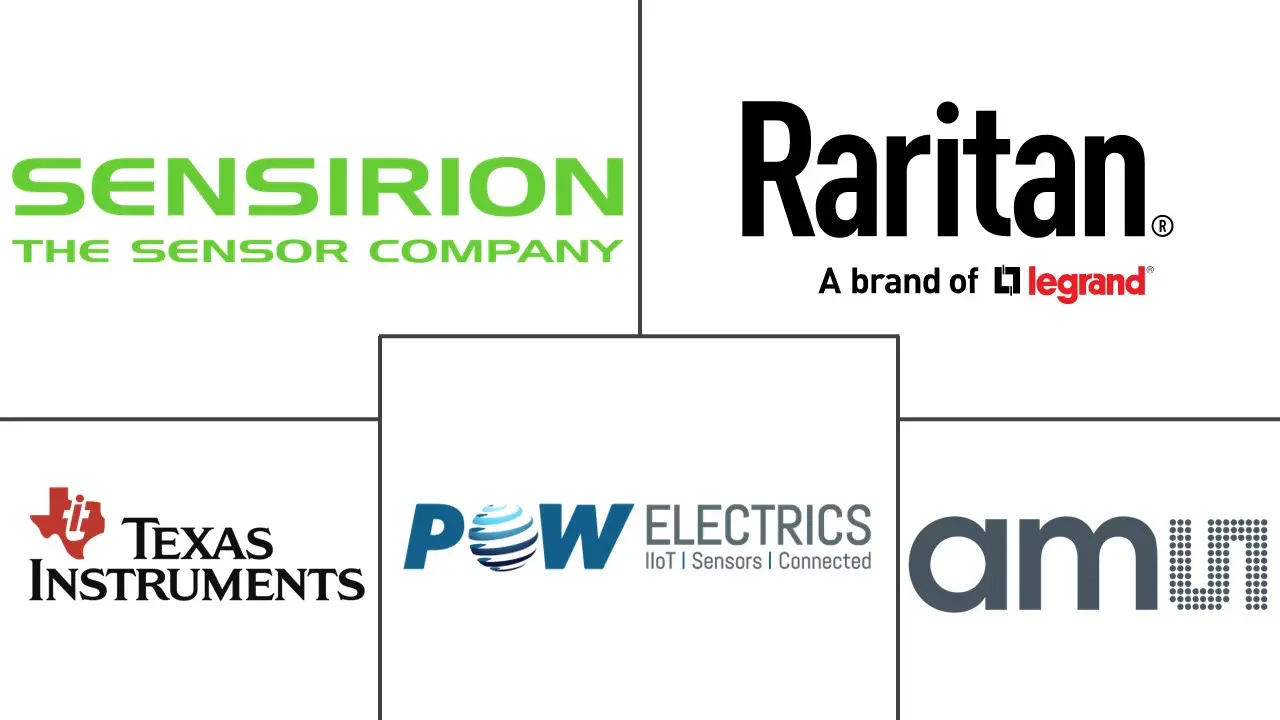Market Size of Environmental Sensors Industry

| Study Period | 2019 - 2029 |
| Base Year For Estimation | 2023 |
| CAGR | 9.20 % |
| Fastest Growing Market | Asia Pacific |
| Largest Market | North America |
| Market Concentration | Medium |
Major Players
*Disclaimer: Major Players sorted in no particular order |
Environmental Sensors Market Analysis
The environmental sensors market is expected to grow by registering a CAGR of 9.25% during the forecast period. The market for environmental sensors is anticipated to experience considerable growth potential due to the rise in pollution yearly brought on by increased air travel, autos, and other factors. The development of Industry 4.0, which develops a market for environmental sensors, adds to this.
- The growth of the global population has led to increased industrial development and activity simultaneously. The unsustainable practices across industries have resulted in rapid degradation of soil, air, and water quality worldwide, which has, in turn, led to an increase in the demand for devices that can help detect environmental changes.
- The environmental sensor market is supported by the growing number of government initiatives for curbing environmental pollution. For instance, the government's increasing focus worldwide on monitoring ecological pollution and reducing the number of deaths due to gaseous pollution is anticipated to increase environmental sensors' demand.
- Further, with the Industry 4.0 developments, environmental sensors are expected to collectively reap the benefits of multiple innovative and brilliant city initiatives. For instance, machine-to-machine (M2M) is scheduled to include interaction between technologies (such as factory floor sensors) to enhance manufacturing processes and safety.
- Companies are focused on providing industrial sensors dedicated to the chemical industry to cater to various needs. For instance, Sensortech Systems offers RF Series moisture sensor that includes moisture measurement for powdered chemical products. The company also gives IR Series moisture analyzers that provide a non-contact continuous online moisture measurement. This line of sensors further automation in chemical industries.
- However, lack of awareness, budgetary constraints to adopting new technology, and regularity models are the restraints to the growth of environmental sensing.
- Though the pandemic has increased concerns in the industrial sector, it has decreased pollution across the globe. One of the most tangible and immediate environmental manifestations of the coronavirus pandemic has been ameliorated air quality due to reduced air pollutant emissions. This is because lockdowns and closures worldwide led to reduced energy consumption, transportation use, and oil demand. In China, for instance, the emission of NO2 (nitrogen dioxide) dropped by 70% between January and February, according to a study published in May in the multidisciplinary journal Air Quality, Atmosphere, and Health. In India, a reduction of 20-30% was noted.
Environmental Sensors Industry Segmentation
Environmental sensors are critical for making a more connected world possible. From providing information on the immediate surroundings to help tackle global climate change, sensors and sensor networks have been fundamentally changing awareness of the detrimental factors that affect the environment. The market study categorizes the analysis of the environmental sensors manufactured and provided by various vendors in different regions. The study categorizes environmental sensors by product type, sensing type, end-user vertical, and geography.
The Environmental Sensors Market is Segmented by Product Type (Fixed, Portable), Sensing Type (Humidity, Temperature, Gas, Pressure), End-user (Medical, Consumer Electronics, Industrial, and Automotive), and Geography. The market sizes and forecasts are provided in terms of value (USD million) for all the above segments.
| By Product Type | |
| Fixed | |
| Portable |
| By Sensing Type | |
| Humidity | |
| Temperature | |
| Gas | |
| Pressure |
| By End-user | |
| Medical | |
| Consumer Electronics | |
| Industrial | |
| Automotive | |
| Other End-users |
| Geography | ||||||
| ||||||
| ||||||
| ||||||
| Rest of the World |
Environmental Sensors Market Size Summary
The environmental sensors market is poised for significant expansion, driven by increasing pollution levels due to factors like air travel and automotive emissions, alongside the advancements in Industry 4.0. The surge in global population and industrial activities has exacerbated environmental degradation, heightening the demand for sensors capable of monitoring and detecting changes in air, soil, and water quality. Government initiatives worldwide aimed at reducing pollution and enhancing ecological monitoring further bolster the market's growth prospects. The integration of environmental sensors within smart city projects and Industry 4.0 developments, such as machine-to-machine interactions, is expected to enhance manufacturing processes and safety, thereby increasing the adoption of these sensors across various sectors.
The Asia-Pacific region emerges as a key driver of market growth, fueled by the rapid adoption of smart technologies and connected devices. Countries like India are witnessing a surge in sensor applications across industries such as automotive, healthcare, and smart homes, supported by significant government investments in advanced technologies and infrastructure. The market is characterized by moderate competition, with major players like AMS AG, Powelectrics Limited, and Honeywell International actively engaging in collaborations, innovations, and strategic acquisitions to enhance their product offerings. The ongoing development of environment-friendly industries and government-funded pollution control initiatives further contribute to the positive outlook of the environmental sensors market globally.
Environmental Sensors Market Size - Table of Contents
-
1. MARKET INSIGHTS
-
1.1 Market Overview
-
-
2. MARKET SEGMENTATION
-
2.1 By Product Type
-
2.1.1 Fixed
-
2.1.2 Portable
-
-
2.2 By Sensing Type
-
2.2.1 Humidity
-
2.2.2 Temperature
-
2.2.3 Gas
-
2.2.4 Pressure
-
-
2.3 By End-user
-
2.3.1 Medical
-
2.3.2 Consumer Electronics
-
2.3.3 Industrial
-
2.3.4 Automotive
-
2.3.5 Other End-users
-
-
2.4 Geography
-
2.4.1 North America
-
2.4.1.1 United States
-
2.4.1.2 Canada
-
-
2.4.2 Europe
-
2.4.2.1 Germany
-
2.4.2.2 United Kingdom
-
2.4.2.3 France
-
2.4.2.4 Rest of Europe
-
-
2.4.3 Asia Pacific
-
2.4.3.1 China
-
2.4.3.2 Japan
-
2.4.3.3 India
-
2.4.3.4 Rest of Asia-Pacific
-
-
2.4.4 Rest of the World
-
-
Environmental Sensors Market Size FAQs
What is the current Environmental Sensors Market size?
The Environmental Sensors Market is projected to register a CAGR of 9.20% during the forecast period (2024-2029)
Who are the key players in Environmental Sensors Market?
AMS AG, Powelectrics Limited, Texas Instruments Inc., Raritan Inc. and Sensirion Holding AG are the major companies operating in the Environmental Sensors Market.

